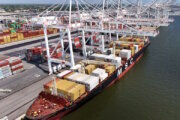MEXICO CITY (AP) — Mexico’s two main drug cartels have long taken their deadly rivalry with them as they expand into distant markets from Asia to Australia to Africa, but never before with such intensive street gang violence and a presidential declaration of a state of “internal armed conflict” this week in Ecuador.
Gunmen from an Ecuadorian gang believed aligned with Mexico’s Jalisco New Generation cartel took over a television station during a live broadcast and brandished explosives. Meanwhile, a rival gang believed to be backed by Mexico’s Sinaloa cartel called for peace — in a statement apparently issued from Mexico City.
Why are Mexican cartels in Ecuador? It’s the location. And the bananas.
Ecuador is attractive as a shipping point for drugs because the South American country is sandwiched between two top cocaine producers, Colombia and Peru. Ecuador has been ravished by poverty, the COVID-19 pandemic, a weak law enforcement system and corruption, but it also has a big active, legitimate foreign trade.
Ships sail to ports in the U.S. and Europe with huge containers of bananas — Ecuador is the world’s top exporter — and those are good places to hide cocaine.
“You have a confluence of factors and, yes, you have bananas, a huge amount of containers and establishments and cover to be smuggling around the world in Europe, across Europe to Turkey, and to other parts of the world,” said Vanda Felbab-Brown, a senior fellow in the Strobe Talbott Center for Security, Strategy, and Technology at the Brookings Institute.
In a few short years, experts say, the experience and muscle of the Mexican cartels has turned Ecuador into the shipment point for almost one-third of the cocaine entering Europe.
According to a 2023 report by the United Nations Office on Drugs and Crime, “the proportion of cocaine reported to the Regional Intelligence Office for Western Europe with Ecuador identified as a departure point rose from 14 per cent in 2018 to 29 percent in 2020 and 28 per cent in 2021.”
Much of that cocaine was connected to Mexican cartels, who have moved into producer countries like Colombia following the 2016 peace accords there with leftist rebels. Coca bush fields in Colombia have also been moving closer to the border with Ecuador due to the breakup of criminal groups after the 2016 demobilization of the Revolutionary Armed Forces of Colombia.
In Mexico, from where the cartels ship mostly fentanyl and meth to the United States, the battle between the Sinaloa and Jalisco cartels has caused a persistent, decade-long wave of violence.
Something similar can be seen in Ecuador, but at an astoundingly rapid rate. The homicide rate in Ecuador skyrocketed from about six homicides per 100,000 people in 2016 — comparable to the United States — to around 40 per 100,000 in 2023.
The Mexican cartels’ business model abroad is largely copied from their domestic playbook: assert control over territory by recruiting local gangs with offers of guns and cash. Then ruthlessly battle the rival cartel for control of territory.
“You will see the Jalisco cartel or the Sinaloa cartel insisting that the local criminal groups chose between them, that you’re only with one or the other, and act violently against rival groups who make a different choice,” Felbab-Brown said.
“So this has playing out in Ecuador,” she said.
The problem worsened when the Mexican cartels stopped paying the local gangs in cash, and began paying them in drugs instead, said Fernando Carrión, a political science professor at the Latin American Faculty of Social Sciences in Ecuador.
The local gangs “have to sell those drugs in local markets, and that forces local gangs to organize, increases local (drug) consumption and laundering, and for this reason also increases the violence,” Carrión said, as street-dealing turf battles cause homicide rates to spike.
That’s why you don’t see Mexican cartels sending their own flashy, heavily armed troops or their armored vehicles to Ecuador; Ecuadorians are doing the dying, in what Carrión describes as a form of outsourcing.
“They connect in Ecuador with other organizations in an outsourcing scheme,” Carrión said. “In the concrete case of the two Mexican groups, Sinaloa is connected to the ‘Choneros,’” one of Ecuador’s oldest gangs.
Jalisco New Generation is connected to the Lobos, or Wolves, which like Jalisco itself is a more recent upstart, he said. Jalisco also apparently works with the Tiguerones, the gang that took over the television station this week. “In this outsourcing scheme, these (local) groups perform certain tasks,” Carrión said, like guarding or transporting cocaine shipments overland to seaports.
The local gangs’ power is frightening, and extends from the prisons to the streets.
In August, presidential candidate Fernando Villavicencio was assassinated less than two weeks before the election. He had complained of receiving threats from the Choneros, the gang associated with the Sinaloa cartel. A couple of months later, six suspects in the assassination, all Colombians, were killed in prison.
Last Sunday, the leader of the Choneros, Adolfo Macías, disappeared from the prison where he was held. Since Macías’ apparent escape, gangs have kidnapped police officers and inmates have taken at least 178 corrections personnel hostage.
On Tuesday, after the takeover of the TV station, President Daniel Noboa designated 20 drug-trafficking gangs as terrorist groups and authorized the military to “neutralize” them. Whether the government can regain the upper hand remains to be seen.
Ecuador is not alone. Countries as far away as New Zealand and Australia have seen violence spike as Mexican cartels arrived.
According to a 2016 report for Australia’s Strategic & Defence Studies Centre by Dr, Anthea McCarthy-Jones, “for Australia, the emergence of Mexican drug cartels in local markets presents not only criminal but strategic challenges.”
“Their presence threatens to not only increase the supply of illicit drugs in Australia, but encourage turf wars, increase the amount of guns in the country, tax border security resources and threaten the stability and good governance of South Pacific transit spots,” according to the report.
Felbab-Brown said the violence spurred by Mexican cartels is threatening countries previously considered peaceful. Ecuador itself was actively promoted in recent years as a safe haven for American retirees.
“The aggressions and the bipolar war, and the voraciousness of the Mexican cartels is having disastrous effects across the Americas. It’s working out and blowing up markets that were long considered to be places of safe haven, these islands of stability and peace, like Costa Rica, Chile.”
“Ecuador is the epicenter of violence right now, it’s dramatic brazen behavior, intimidation, aggression by the local criminal groups, so it’s at the forefront, but the role of the Mexican cartels has been pernicious south of Chiapas” — on Mexico’s border with Guatemala — “across the entire continent.”
Copyright © 2024 The Associated Press. All rights reserved. This material may not be published, broadcast, written or redistributed.






